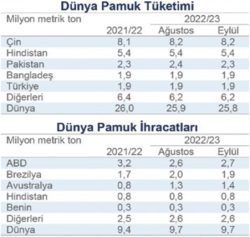Recent price movement
Movement in benchmark prices was mixed over the past month.
• The December NY/ICE futures contract climbed higher in the second half of August, but it lost 12% in the last week of the month (from 117 to 103 cents/lb between August 29th and September 2nd). More recently, values have been trading between 101 and 105 cents/lb.
• After rising most of the month, the A Index also fell near the end of August, dropping from 134 to 122 cents/lb.
• The China Cotton Index (CC 3128B) has been the lowest of all cotton benchmarks since the middle of August. Prices moved slightly lower recently, with current values touching the lowest levels since January 2021 (103 cents/ lb, when they were 26 cents/lb higher than the NY/ICE Nearby). The CC Index traded between 15,650 and 16,000 RMB/ton in domestic terms over the past month. The RMB weakened against the dollar from 6.75 to 6.95 RMB/USD.
• Indian spot prices (Shankar-6 quality) have been the highest benchmark since late June (after surpassing the A Index, which includes shipment to East Asian ports). Over the past month, values eased slightly, from 158 to 143 cents/lb or from 96,000 to 89,000 INR/candy. The INR was steady against the USD, around 80 INR/USD.
• With the outbreak of flooding, Pakistani spot prices increased from 102 to as much as 127 cents/lb by the end of August. More recently, prices retreated to 117 cents/lb. In domestic terms, prices increased from 18,000 to 22,000 PKR/ maund. The PKR weakened against the USD, from 215 to 230 PKR/USD over the past month.
Supply, Demand & Trade
The latest USDA report featured an increase for 2022/23 global production (+1.4 million bales to 118.4 million) and a decrease for 2022/23 global mill-use (-460,000 bales to 118.6 million). Along with revisions to historical figures, these changes boosted the USDA’s forecast for 2022/23 ending stocks by 2.0 million bales (to 84.8 million). Flooding in Pakistan pulled the forecast for Pakistani production – 700,000 bales lower (to 5.5 million). Another major country-level change was for the U.S., where the crop estimate increased +1.3 million bales (to 13.8 million) due to a large upward revision in planted acreage (+1.3 million acres relative to the August number). Other notable changes included updates for Australia (+500,000 bales to 6.0 million), China (+500,000 to 28.0 million), Turkey (+100,000 to 4.4 million), Togo (-105,000 to 105,000), and Uzbekistan (-200,000 to 2.7 million). At the country-level, the largest changes for mill-use were for Pakistan (-400,000 bales to 10.5 million) and Vietnam (-100,000 to 6.8 million). The global trade estimate was unchanged at 44.6 million bales. Import figures were lowered for Turkey (-100,000 bales to 4.8 million) and Vietnam (-100,000 to 6.9 million) but were increased for Pakistan (+200,000 to 5.0 million). The export figure was lowered for Brazil (-700,000 bales to 8.6 million) but increased for Mexico (+100,000 to 500,000), Australia (+200,000 to 6.4 million), and the U.S. (+600,000 bales to 12.6 million).












